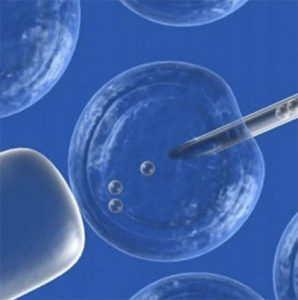
14 4月 试管婴儿期间是否可以选择性别?
植入前遗传诊断(PGD)的程序给出了选择胚胎的正确性别。 这通常被认为是必要的。 毕竟,未来的父母需要承担一个完全健康的后代,没有任何通过性染色体传播的遗传性疾病。
婴儿属于某种性别将由遗传物质决定,遗传物质将与男性生殖细胞一起渗透。 卵子含有2条X染色体,而精子含有X和Y.因此,当X染色体合并时,应该期待一个女孩,当X和Y合并时,一个男孩。
遗传信息是在胎儿发育的第一阶段形成的。 受精后,胚胎只有女人的性特征。 女孩/男孩的器官受X或Y染色体的影响。
是否可以通过IVF计划性行为?
鉴于这种类型的受精发生在子宫外,婴儿性别的选择是真实的。 毕竟,孩子最初在类似于女性身体的人工制度下在试管中发育。
植入前基因诊断在IVF之前进行。 该分析由分子生物学水平的专家进行。 该程序通常对已经3-5天大的胚胎进行。 由于PGD,医生可以识别胎儿中的150多种疾病,包括:
-血友病;
-唐氏综合症;
-囊性纤维化。
这个过程包括选择不携带遗传性疾病的胚胎。 为此目的,在分裂阶段对其中一个胚泡进行活组织检查。 他的遗传物质在显微镜下仔细研究。
由于PGD的实施,很有可能确定胎儿的性别。 这个程序的主要任务是选择没有异常的胚胎。 如果家庭患有与性别有关的疾病,则进行。 只有一个健康的胚胎种植在准妈妈的子宫内。
PGD的适应症
在特殊情况下,建议对夫妇进行植入前基因诊断:
-该程序适用于那些具有核型染色体病理的夫妇。 在这种情况下,将现有异常传递给后代的风险非常高;
-在专家无法确定植入失败的原因的情况下。 植入子宫腔内的胚胎可能含有使胎儿发育不可能的遗传病状;
-以前因胚胎病变而流产;
-给35岁以上的妇女。 卵子的质量随着年龄的增长而变差,胚胎染色体内各种异常的风险增加。
在IVF过程中,由于精子在试管中受精。 精子被注入雌性生殖细胞并观察其受精情况。 具有任意基因型的精子随机渗透到卵细胞中,形成合子。在IVF过程中,由于精子在试管中受精。 精子被注入雌性生殖细胞并观察其受精情况。 具有任意基因型的精子随机渗透到卵细胞中,形成合子。

ICSI类型的受精以完全不同的方式发生。 通过胞浆内精子注射,将选定的精子插入雌性生殖细胞。 此操作是在显微镜下进行的,因为它是显微手术。 通常,在这种情况下,IVF-ICSI被诉诸:
-严重的男性不育;
-如果鸡蛋有厚胶囊;
-如果以前的IVF程序不成功。
成功体外受精后,胚胎在雄性和雌性生殖细胞融合后3-5天进行彻底检查。
进行的诊断是必要的:
-性别定义;
-检查胎儿是否存在遗传性疾病。
如果测试结果排除了存在异常的可能性,那么专家将胚胎放置在准妈妈的子宫内。
如果您需要排除遗传性病理或只是对未出生婴儿进行性别选择,请在IVF之前进行PGD。 孩子的性别认同是100%正确确定的。
在进行人工授精后,将通过PGD的剩余胚胎冷冻。 如果试图怀孕以失败告终,这对于将它们重新放置在患者的子宫内是必要的。

